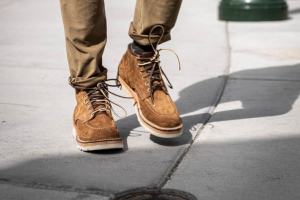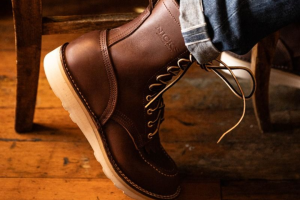Why Wedge Boots?
Why not wedge boots? They're amazing! It's a very popular style for work and for casual wear, and for a lot of great reasons.
Unless you work outdoors or anticipate some very slippery conditions, wedge boots are a great choice for work boots. They're a classic work boot style and all the big names in work boots make them.
In recent years, wedge boots have also caught on for casual wear, which is why you'll usually see a pair of wedge boots in a lot of heritage boot lines.
Why should you get a pair?
Wedge Boots Have a Flatter Heel Profile
One thing you'll notice with a pair of wedge boots is how they feel a lot closer to a pair of sneakers in a way than typical work boots do.
They feel that way because the wedge sole has less heel drop, meaning there's less vertical distance between your heel and the instep of your foot. Typical work boots - and certainly work boots that are the logger style - have a raised heel, meaning greater heel drop.
If you'd rather wear a boot that has more of a flat-footed feel, sort of like a "barefoot" shoe, wedge boots are some of the only work boots that will give you that.
Wedge Sole Work Boots Are Amazing On Concrete
Factory workers, mechanics and iron workers swear by the classic wedge sole work boot style (Red Wing, Thorogood, etc.) because the thick wedge sole is amazing on hard surfaces.
That's because it's a big block of rubber. Having that thick wedge between your feet and hard surfaces provides a lot of shock absorption, which is why factory workers, mechanics, iron workers, postal workers wear them religiously.
For casual wear, that also makes a wedge sole boot incredibly comfortable in the urban environment.
Walking up and down city streets, going up and down staircases and so on can actually beat up your feet, ankles and knees more than you'd think.
Some people think a logger-style heel is complete overkill if you're just wearing your boots to the office. It's kind of like driving a Jeep Wrangler in the city; you can, and some people do, but it's really made for off-roading and you're going to notice it when you go over a speedbump.
When You Shouldn't Get Wedge Boots
Every kind or style or whatever you want to call it of work boot has strengths and weaknesses.
Where wedge boots start to get shown up by other boot designs is in a few areas.
For one, what the classic wedge boots from the classic manufacturers usually lack is arch support. People with high arches or other orthotic issues usually have to toss the factory insoles for a pair of Spencos or other arch support inserts.
Having to spend more money on top of buying a pair of supposedly great work boots is not amusing.
If you need more than the typical boot provides, make sure you look for boots with arch support built into the footbed. A little more investment in build quality will usually pay dividends in comfort.
Wedge soles, whether it's the classic Christy Cremes or other wedge sole from Vibram or derivatives thereof, are notoriously lousy in heavy rain and snow.
They don't have a lot of traction, so you need to either get different boots if you need serious traction or get a pair of winter boots for the wet and cold season.
And, let's face it, not everyone actually likes a moc toe. They look great for about the first year, but eventually the boot flattens out (unless you religiously use shoe trees) and they start to look like a car ran them over.
Wedge boots are some of the best for work or casual wear, so long as you're getting them for what they do instead of what they don't.





